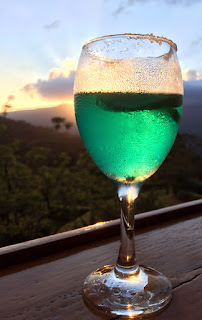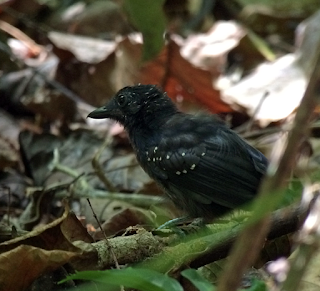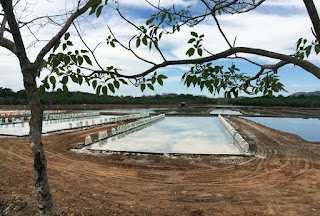 |
| Note: we started from the Buena Vista, not the Bougainvillea |
 |
| balcony view |
 |
| a very relieved Dar with Carol |
 |
| Lance, Michael, Amanda, Nancy |
 |
| Matt, Michael, Dar, Nancy |
 |
| Debs demonstrates proper desert sharing etiquette |
Our second group were all members of the Northeast Wisconsin Bird Club and knew each other very well. In addition to Dar and Stuart, the group would include Matthew King, Nancy Johnson, her 12-yr old son Michael, her husband Lance and their daughter Amanda. This was the first time we had an entire family join us on a tour. Nancy and Michal were the birders. Lance and Amanda were not quite so keen on birding but because Lance had a lot of international travel under his belt, they assured us that he and Amanda would be quite comfortable fending for themselves.
 |
| excited to be in a warm climate |
On Sunday March 14, the first official start of our tour, we were joined by our guide Richard Garrigues. We also learned that Carlos, our driver during our first tour, would again be our driver during tour number two. Excellent!
 |
| Villa Lappis lodging |
 |
| celebrating number 2,000! |
 |
| all aboard for the Rio Tarcloes |
Rejoined by Stuart and following breakfast, we gathered our luggage, boarded our bus and set out on the first leg of our tour toward the Pacific Ocean side of the country. Our first overnight? The Hotel Villa Lapas. This was the only lodging overlap from our first tour but a welcome revisit nevertheless. Venturing into Carara National Park never disappoints.
 |
| fiery-billed aracari |
 |
| red-capped manakin |
 |
| slaty-tailed trogon |
 |
| black-headed trogon |
 |
| scarlet macaw |
 |
| ferruginous pygmy-owl |
 |
| Panama flycatcher |
 |
| buff-fronted quail-dove |
A late afternoon stop at a nearby preserve with several hummingbird feeders put us in close proximity with green hermit, green violetear, green-crowned brilliant, purple-throated mountain-gem, violet sabrewing, stripe-tailed hummingbird, steely-vented hummingbird, and coppery-headed emerald.
 |
| golden-olive woodpecker |
 |
| blue-crowned motmot |
The next full day was split into visiting two different habitats separated by elevation . Going a bit lower into a drier habitat to the Santuario Ecologico Preserve, we picked up species that included white hawk, groove-billed ani, gray-headed chachalaca, orange-belled trogon, orange-chinned parakeet, red-faced spinetail, brown-crested flycatcher, masked tityra, barred becard, rufous-and-white wren, rufous-naped wren, mottled owl, black-headed nightingale-thrush, collared redstart, golden-crowned warbler, Passerini’s tanager, spangle-cheeked tanager, slaty flowerpiercer, stripe-headed sparrow, and blue grosbeak.
 |
| northern barred woodcreeper |
 |
| gray-crowned yellowthroat |
 |
| resplendent quetzal |
 |
| room with a view and gourmet food at Celeste |
 |
| civilized birding |
 |
| the "forget the horses!" bare-necked umbrellabird |
 |
| our cabin - lovely but impractical in so many ways |
Heliconias was, well, different. At least the accommodations. It had started out as a modest research station but eventually was expanded into a lodge. During the expansion, more attention was paid to looks rather than function. It was as if someone drew up plans for the cabins but never spent any time in them. Our cabin, while quite lovely, had plenty of space but electrical outlets were placed in odd locations. The shower was a hand-held wand which in itself wasn’t strange. But the wand’s placement meant having to step into a very deep whirlpool bath with no shower curtain and with no comfortable place to sit. Getting to the cabins required having to pull luggage along an inclined gravel trail for some distance (pavers would have been very helpful). Were it not for our driver’s assistance, we all might have suffered back problems.
 |
| suspension bridges and lattice-tailed trogon (female) |
One of our most exciting birding events on the trip occurred while at Heliconias. We encountered an Army ant swarm that had attracted several species of antbirds: dull-mantled, Zeledon’s, bicolored, spotted and the stunning ocellated. Typically these are all skulkers of the first order and hard to see but due to the foraging ants, hundreds of insects were desperately fleeing which in turn had tempted the antbirds out of the shadows.
 |
| entrance to Hotel de Campo Caño Negro and Lago Caño Negro wetlands |
Shortly after arriving, we took the first of two boat tours on the Rio Frio eventually winding up in a vast shallow wetland lake, Lago Caño Negro. The trip list was quickly fleshed out with: bare-throated tiger-heron, great egret, snowy egret, little blue heron, tricolored heron, green heron, boat-billed heron, glossy ibis, roseate spoonbill, gray-necked wood-rail, limpkin, black-necked stilt, collared plover, ringed kingfisher, amazon kingfisher, green kingfisher, American pygmy kingfisher, peregrine falcon, white-tailed hawk, and black-collared hawk.
Late in the afternoon as light was fading in Lago Caño Negro, we chanced upon a very difficult bird to see: yellow-breasted crake. Unfortunately not everyone got to see the bird but given we were going to do a second boat trip the next morning, hopes were high that the rest of the group might see the crake.
 |
| "Fonzy" |
Up early the next morning we set out again on the Rio Frio and headed directly to the spot where the crake had been seen the day before. This time the bird was extremely cooperative. Everyone was rewarded with incredible looks at not just one but two crakes. Along the way we found rafts of black-bellied whistling-ducks, several wood storks, a much sought after jabiru followed by Nicaraguan grackles, a white-tailed kite, purple gallinules, and groove-billed anis. From the lake we steered back to the river channel where it wove through dense canopy. More closeups of one of the groups’ favorite birds: the diminutive American pygmy kingfisher. Overhead, jumping from tree to tree were white-headed Capuchin plus some Central American squirrel monkeys.
 |
| agami heron |
Returning to the lodge, some of the group sought relief from the afternoon heat and humidity in the lodge’s swimming pool while others continued to bird the lodge grounds and adjoining properties. For their efforts (the those who birded - not the swimmers) they were rewarded with olivaceous piculet, pale-billed woodpecker, bronzy hermit, green-breasted mango, red-throated ant-tanager, thick-billed seed-finch, golden-hooded tanager, palm tanager, spot-breasted wren, white-collared manakin, fork-tailed flycatcher, scissor-tailed flycatcher, rufous mourner, yellow tyrannulet, cocoa woodcreeper, olive-throated parakeet, lineated woodpecker, collared aracari, gray-headed dove, and pale-vented pigeon.
 |
| Catarata del Toro |
 |
| Poas Volcano |
Vaux’s swifts were out in good numbers as was one of our target birds, the fiery-throated hummingbird. When the sun hits these hummingbirds just right, views consist of a riot of iridescent colors. Hiking some of the trails produced other high elevation species. Scintillant hummingbird, prong-billed barbet, a highly sought after silvery-fronted tapaculo, spot-crowned woodpecker, mountain elaenia, yellow-winged vireo, black-billed nightingale-thrush, sooty thrush, black-and-yellow silky-flycatcher, long-tailed silky flycatcher, rufous-capped warbler, and another major target bird: wrenthrush (we don’t always get to see one on every visit to Poas). Peg-legged finch, yellow-thighed finch, large-footed finch, and sooty-capped bush-tanager rounded out the Poas list.
 |
| volcano hummingbird |
 |
| Amanda's bracelet |
 |
| 2-toed sloth |
 |
| Buena Vista Hotel (headed back in 2017) |
And our bird tally? It was a whopping 504 species seen with an additional 5 species as heard only. By far this was the best bird tally of any of our previous tours and the previous two week tour wasn’t anything to sneeze at! The weather was on our side. We enjoyed terrific food both at the lodges and during our many roadside stops. The group camaraderie was keen and even the non-birders in the group agreed that this had been one of the best trips they had ever taken.
 |
| Richard's latest project now in print |
















































































Excellent write-up!!! I had a smile on my face from beginning to end - such great memories with an outstanding group of birders/friends. Truly a magical trip.
ReplyDeleteYes, Stuart not only owes us that beer, but I'm from Wisconsin and around here we charge interest so he better bring the credit card!